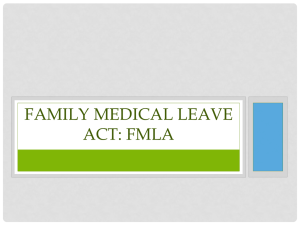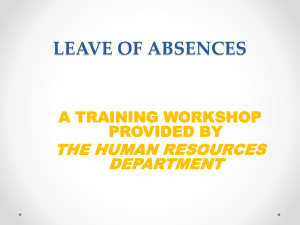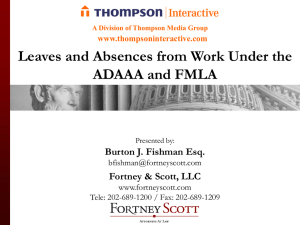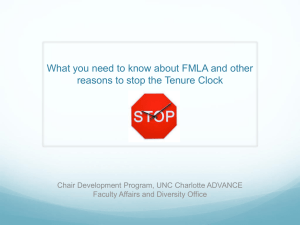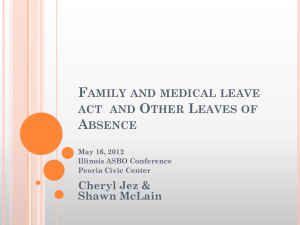EDLP 704 – Abuse of FMLA – Policy Article Presentation_Ultimate
advertisement
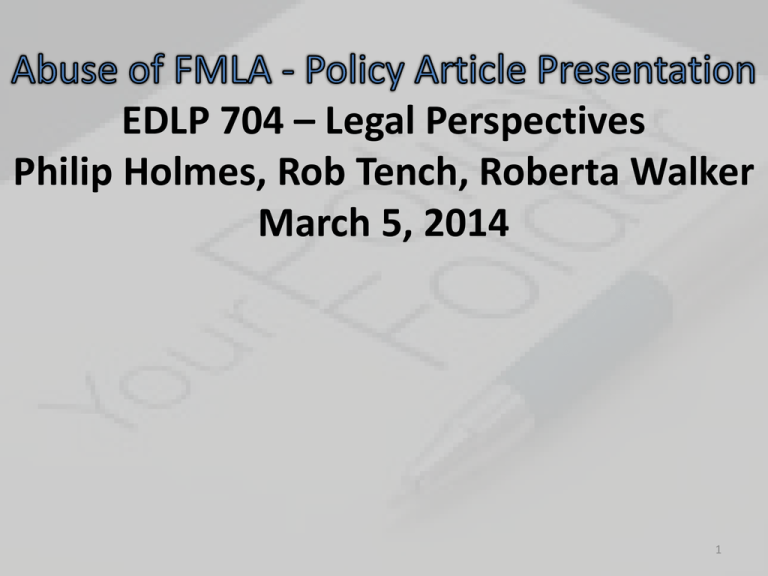
EDLP 704 – Legal Perspectives Philip Holmes, Rob Tench, Roberta Walker March 5, 2014 1 The Family Medical Leave Act (FMLA) entitles eligible employees of covered employers to take unpaid, job-protected leave for specified family and medical reasons with continuation of group health insurance coverage under the same terms and conditions as if the employee had not taken leave. 2 FMLA entitles employees to: • Twelve workweeks of leave in a 12-month period for: – the birth of a child and to care for the newborn child within one year of birth; – the placement with the employee of a child for adoption or foster care and to care for the newly placed child within one year of placement; 3 FMLA entitles employees to: – to care for the employee’s spouse, child, or parent who has a serious health condition; – a serious health condition that makes the employee unable to perform the essential functions of his or her job; – any qualifying exigency arising out of the fact that the employee’s spouse, son, daughter, or parent is a covered military member on “covered active duty;” or 4 FMLA entitles employees to: • Twenty-six workweeks of leave during a single 12-month period to care for a covered service member with a serious injury or illness if the eligible employee is the service member’s spouse, son, daughter, parent, or next of kin (military caregiver leave). 5 Item One – Roberta Walker BRIEFLY SUMMARIZE THE ARTICLE, DESCRIBING ANY RESEARCH, THEORIES, ANY FINDINGS OR CONCLUSIONS 6 No More Half Measures: A Case-Based Approach for Addressing FMLA Abuse by: Dana S. Connell Cases presented in this article: confirm that employees are abusing FMLA. identify lawful options that an employer may take to obtain “line-of-sight” to the employee’s activity while on leave. identify a process for preparing for and dealing with FMLA abuse situations. 7 8 Employees are entitled to FMLA leave only if they have a health condition “that makes the employee unable to perform the functions of the position of such an employee.” FMLA’s restoration obligation is limited to employees on leave “for the intended purpose of the leave.” FMLA regulations recognize that an employee “has no greater right to reinstatement … than if the employee had been continually employed during the FMLA leave period.” 9 originated in Kariotis v. Navistar Transportation Corp. wherein the court sided with the employee, stating, “the question is not whether the employer’s reasons for a decision are right but whether the employer’s description of its reasons is honest .” 10 The “Honest Belief” Rule The Sixth Circuit, in Smith v. Chrysler Corporation, imposed additional requirements on the employer, noting that the employer has to show that its belief is “reasonably grounded on particularized facts” that are available during the employment decision. 11 Seven Basic Types of Employee FMLA Abuse: 1. Working a second job “on the side,” in violation of an express written policy prohibiting the employee from doing so 2. Working a second job on the side, where there is no written policy that specifically prohibits it 3. Engaging in manual labor 12 Seven Basic Types of Employee FMLA Abuse: 4. Running errands or shopping 5. Partying or engaging in other social or recreational activities 6. Sneaking off on a pleasure trip 7. Failing to take care of a family member (if on family-care) 13 Working on the Side During FMLA in Violation of an Express Policy • An employer may apply a “no moonlighting policy” to employees on FMLA leave, as long as it also applies that policy to employees on other leaves of absence. • Vail v. Raybestos Products Co . 14 Working on the Side During FMLA When There is No Written Policy • Lackman v. Recovery Services of New Jersey, Inc. • Dietrich v. Susquehanna Valley Surgery Center “Any employee … might reasonably expect the employer to take disciplinary action if he or she is absent from work and found to be instead engaging in some other side business. This is especially true if the employee failed to notify his or her employer of the impending absence, but such behavior can reasonably be seen as dishonest and worthy of discipline even if the excused absence was requested.” 15 Employee Engages in Manual Labor During FMLA • Crouch v. Whirlpool Corp. 16 Employee Runs Errands or Goes Shopping While on FMLA • Callison v. City of Philadelphia – The “stay-athome” policy required an employee “to remain at home except for personal needs related to the reason for being on sick leave.” • Colburn v. Park-Hannifin/Nichols Portland Division 17 Employee “Parties” While on FMLA Jaszczyszyn v. Advantage Health Physician Network- The Sixth Circuit found that the employer “rightfully considered workplace FMLA fraud to be a serious issue” and affirmed the dismissal of Jaszczyszyn’s FMLA retaliation claim because “she failed to disprove the employer’s honest belief that her behavior in the photos contradicted her claims of total disability.” 18 Employee Sneaks Off on Pleasure Trip • Pellegrino v. CWA • Lineberry v. Richards, et al. 19 Employee Fails to Take Care of Family Member on FMLA • Scruggs v. Carrier Corp. • Hamm v. Nestle USA, Inc. 20 Suspicious Behavior Suggesting FMLA Abuse • Taking FMLA after being denied vacation or personal leave • A pattern of Friday and/or Monday absences • Direct or anonymous complaints or tips from coworkers 21 The article review revealed… • the employer’s capacity to take action concerning various types of FMLA abuse • the value of policies, including those that prohibit falsification • that surveillance videos, private investigators, Facebook, asking effective questions and placing phone calls are lawful, compelling and legitimate means of addressing FMLA abuse 22 Item Two – Phil Holmes and Rob Tench WHAT IS YOUR PERCEPTION OF THE RIGOR OF THE RESEARCH DESCRIBED IN THE ARTICLE? 23 Rigorous - Pro • The article is recently published (Spring, 2014) in a well-respected legal publication (Employee Relations Law Journal) • The author’s research was extensive – More than 70 court cases were reviewed – Interpretation and expansion of court rulings in support of possible responses to FMLA abuse were detailed and in-depth – More than five pages of end notes presented • Article was pragmatic and “real world” 24 Rigorous - Cons • The author is a practicing attorney, not a legal scholar or academician • No literature review is provided, and no references to other articles, books, or studies are cited in the text • The author “represents management in all types of employment issues and litigation,” and reveals surprising animus toward employees who abuse FMLA 25 Rigorous - Cons • The article is tactical, and focuses only on methods to “catch” FMLA abusers and on the judicial review and sanction of those methods. • The extent of FMLA abuse in relation to all FMLA users is not reported, nor does the author explore: – the reasons behind FMLA abuse – the possible ramifications in the workplace of following the author’s advice, such as the use of: • videotaping • co-workers as informants • private investigators 26 Rigorous - Cons • The author did not address key and relevant questions: – Might FMLA abuses be prevented by better communication to potential or actual FMLA users? – To what extent does FMLA abuse reflect underlying conflicts between management and employees? • Of the 13 cases of FMLA abuse that the author cited, 69% (9 of the abusers) involved non-managerial employees; only 1 FMLA abuser is clearly a white-collar employee. • The fact that the majority of FMLA abusers (cited in the article, at least) are “front-line” employees is neither called out nor explored. 27 Item Three – Rob Tench WHAT KIND OF POLICY IS BEING DISCUSSED? EXPLAIN. 28 Policy Type • FMLA and FMLA Abuse Policies are regulatory because they: – contain formalized rules. – require or prohibit certain behaviors. – imply enforcement and penalties for those who break the policies. 29 Policy Type • A FMLA Abuse Policy also has elements of a redistributive policy because it: – shifts power from employees who are abusing FMLA to employers who are trying to either stop the abuse or impose consequences for that abuse. – generates intense conflict between employees and employers who are unlikely to compromise or negotiate their differences. – is marked by sharp divisions and ideological intensity. 30 Item Four – Phil Holmes and Rob Tench WHAT STRATEGIES MIGHT BE USEFUL IN PROMOTING SUPPORT FOR THE POLICY? 31 Promoting Policy Support • This article does not promote or explore the responsible use of the FMLA policy, but instead focuses on: – limitations within the language of FMLA for addressing potential abuses. – lawful options (not spelled out by FMLA but supported by recent court cases) for documenting FMLA abuse and responding appropriately. • Essentially, the article implies de facto amendments to FMLA, in response to the policy’s failure to spell out the options management has when responding to FMLA abuse. • These de facto amendments reflect judicial guidance in the 32 absence of statutory language. Promoting Policy Support • The author’s intention is not to fix FMLA but rather to help employers work within a broken FMLA; thus, the author does not “support” the FMLA policy. • No suggestions are made regarding methods to: – educate employees about FMLA and how to avoid FMLA abuse. – ensure that physicians do not “rubber stamp” FMLA requests and are held accountable when they do. – decrease the adversarial relationship between employers and employees regarding FMLA. – understand the underlying non-FMLA issues between employees and employers that may lead some employees to abuse FMLA. 33 Suggested Strategies • Develop buy-in for the policy among executives, managers, supervisors, and those responsible for enforcing and implementing the policy. • Develop buy-in from employees affected by the policy. • Identify those most likely to support the new policy and cultivate their support (“many employees are ‘rooting’ for the employer to fix FMLA abuse problems”). 34 Suggested Strategies • Conduct an effective campaign to sell the policy • Educate all employees on the policy • Promote the positive aspects and consequences of the policy – Fairness issue – Increased productivity – Decreased absenteeism – Decreased abuse of FMLA – Legitimate use of FMLA 35 Item Five – Phil Holmes WHAT ARE THE BENEFITS OF SUCH A POLICY? 36 Policy Benefits • The author does not spell out the benefits of FMLA; the benefits of the author’s implied amendments to FMLA are: – reduction in FMLA abuse (or increased apprehension and punishment of abusers). • The amount of current FMLA abuse is not reported nor are the financial implications of that abuse. – reduction in management confusion and frustration regarding the failure of the statutory language to define what one can do in response to FMLA abuse. 37 Item Six – Phil Holmes WHAT MIGHT BE UNINTENDED CONSEQUENCES OR DISADVANTAGES OF SUCH A POLICY? 38 Unintended Consequences or Disadvantages of FMLA • The FMLA abuses depicted in the article are among the unintended consequences or disadvantages of FMLA. – These flaws result from weaknesses in the statutory language of FMLA and not from the actual thrust or intention of the policy itself. – No other unintended consequences or disadvantages of FMLA are explicitly noted by the author. 39 Unintended Consequences or Disadvantages of FMLA • The unintended consequences or disadvantages of the author’s implied amendments are: – increased antagonism between employees and employers; – distraction from the underling causes of FMLA abuse, such as issues between employers and employees; and – implicit reduction in the perceived need to tighten the statutory language of FMLA. 40 Item Seven – Phil Holmes, Rob Tench, and Roberta Walker WHAT DID YOU LEARN THAT IS APPLICABLE TO YOU IN YOUR WORKPLACE OR TO YOUR ROLE AS A LEADER? 41 What did we learn? • The key factor in FMLA abuse is whether an employer makes a reasonably informed and considered decision before taking an adverse action against an employee. • The question is not whether the employer’s reasons for a decision are right but whether the employer’s reasons are honest. 42 • Statutory flaws are not necessarily fatal to a policy – The courts will intercede to provide post-facto guidance • Some methods of monitoring FMLA users for possible FMLA abuse that might seem illegal have actually been sanctioned by the courts. – Electronic surveillance, private investigator surveillance, and videotaping by an employer are legitimate and not FMLA violations. – Facebook postings and other social media can be valuable and compelling evidence regarding an employee’s activities while on FMLA. 43 What did we learn? • FMLA was developed to protect the rights of employees and provide them with adequate leave when needed. • The rights of employers to be protected from FMLA abuse and misuse are also important, and are being addressed. • Co-workers also have the right to report suspicions of FMLA abuse. 44 What did we learn? • It is extremely valuable to have a formal FMLA abuse policy that not only addresses falsification issues but also identifies and prohibits the most egregious and frequent FMLA abuses. 45 Questions, Comments, Concerns? 46
